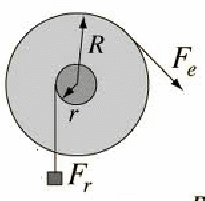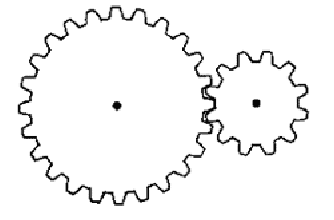The Wheel and Axis Principle
The wheel and axis principle is used to produce a large turning force. It is most frequently used in the gearboxes of cars. A large force is required to start the car moving (low gear), which can be reduced once the car starts to move (high gear).

Assuming the mechanism is 100% efficient, the force done by force F-r is equal to the force needed to move the force F-e .If the axle turns n times, the work done by
![]() is equal to
is equal to![]()
![]() is equal to
is equal to![]()
Equating these gives![]()
The ratio![]() is called the 'mechanical advantage'.
is called the 'mechanical advantage'.

In a set of gears the inner and outer wheels are covered in teeth, which mesh in a 1 – 1 way like the teeth in a zip. This means that driven (inner wheel above) and outer wheel (driving wheel above) rotate so that the teeth intermesh and wheels turn in inverse ratios to their circumference (and radii).
If the outer wheel has N teeth and the inner wheel has n teeth then we may define the velocity ratio as![]()
Each wheel will turn the same distance in the same time so that
![]() and
and![]()
Dividing the first of these by the second gives![]()
The ratio![]() is also equal to
is also equal to![]() so
so![]()